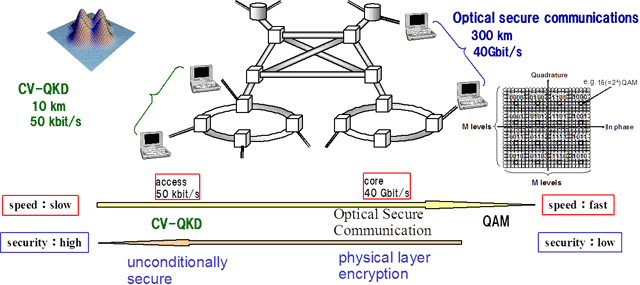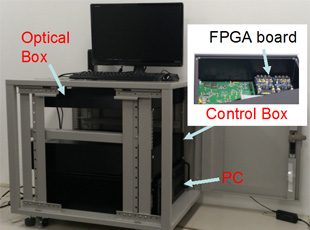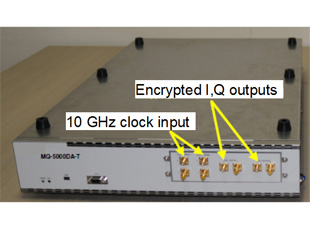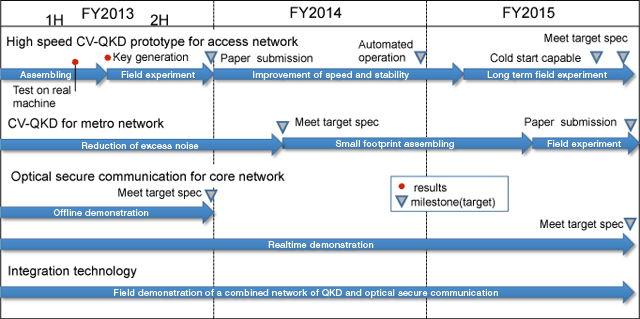
Subject C : Continuous variable QKD and its application
157C-T01QKD and optical secure communications with quandrature amplitude modulation technology
Gakushuin University (Takuya Hirano)
Tohoku University
Our role is to develop continuous-variable (CV) QKD and optical secure communication technologies that can be seamlessly integrated into coherent optical communication systems, based on quadrature amplitude modulation (QAM) and homodyne (or heterodyne) detection of coherent light. Such technologies will enable secure and safe communication infrastructure that can offer diverse functions ranging from unconditionally secure communications to high-speed and high-secure data transmission in a unified way. To achieve above purposes, we set following three subthemes.
- Subtheme 1: CV-QKD system
- The CV-QKD system that is developed in the project will be capable of transmitting information-theoretic secure audio data over an access network. The CV-QKD system will be low in cost and small in footprint. The system will be tested in a field experiment. In the security analysis, the effect of optical losses and excess noise will be taken into account to estimate the information leaked to the eavesdropper and privacy amplification is applied to generate secret key that is secure against an eavesdropper who has unlimited computational power.
- Subtheme 2: Optical secure communication system
- The optical secure communication system we will develop is based on the combination of QAM technologies and stream cipher. By choosing a physically different 2-dimensional set of QAM signals using stream cipher, an enhanced security of physical-layer encryption will be achieved. We will develop an optical secure communication system operating over a core network with a speed that is compatible with today's high speed optical communication.
- Subtheme 3: Integration technologies
- For a future integration of CV-QKD and optical secure communication into coherent optical communication, we develop technologies for low noise operation and high speed operation of QAM system. Field demonstration of a combined network of CV-QKD and optical secure communication will be performed.

Fig. 1CV-QKD system and optical secure communication system
Since both CV-QKD and optical secure communication systems exploit devices that are based on the same operating principle as that of the coherent optical communication, it may be possible in future that an all-in-one sending and receiving equipment offers a full range of secure communication within a tradeoff between the security and speed: by just pushing the button, its operation mode will be able to switch from unconditionally secure metro communication to physically secure core communication, and even to computationally secure conventional high-speed communication.
Interim results for Team 157C-T01
| Task title | Outcome | Date | Note |
|---|---|---|---|
| 1: Long distance CV-QKD prototype | Stable operation of four-state CV QKD over 40 km fiber is realized by utilizing single-path interferometer. | Mar. 2012 | Qcrypto2012 |
| 2a: Security analysis of four-state CV-QKD | Secret key rate against entangling cloner attack is calculated. | Mar. 2012 | QIT27 |
| 2b: Off-line operation of optical secure communication | Proof of principle experiment of two-dimensional cryptography has been successfully conducted. | Mar. 2012 | |
| Demonstration of 2.5 Gsymbol/s, 16 QAM two-dimensional optical secure communication over 160 km fiber. (Fig. 2-1) | Mar. 2013 | ||
| 2c: Low excess noise operation of CV-QKD | Utilizing dispersion compensation method, reduction of excess noise in long distance CV-QKD is achieved. | Sep. 2012 | The JPS autumn meeting 2012. (Student presentation award) |
| 2d: High speed CV-QKD system | 10 MHz operation using a commercially available balanced receiver. | Mar. 2013 | |
| FPGA development system based controller has been fabricated. | Mar. 2013 | ||
| Executable modules for error correction and privacy amplification are tested. | Jul. 2013 | ||
| 3: Real-time optical secure communication | 10 Gbps FPGA-based encryption device has been fabricated. (Fig. 2-2) | Mar. 2013 |

Fig. 2-1CV-QKD system

Fig. 2-210 Gbps encryption device
The CV-QKD system is packaged in two 19 inch racks (Fig.2-1): one is a sender station and the other is a receiver station. Each station is comprised of three parts: optical box, control box, and PC. Components in the optical box are all commercially available ones. The control box contains a FPGA board that is connected to the PC via USB cables. The PC is equipped with a GPU card to accelerate the software-based post-processing. Fig.2-2 shows a real-time encryption device for 10 Gbps two-dimensional optical secure communication. High speed digital processing in FPGA enables the generation of encrypted digital data at 10 Gsample/s and high speed DACs convert the digital data into analog data.
Targets for Team 157C-T01
| Task title | Work/Milestone | Due Date | Note |
|---|---|---|---|
| 1e: High speed CV-QKD system for access network | Generation of secret key using FPGA based controller and the post-processing software over 10 km optical fiber channel | Mar. 2014 | |
| Generation of secret key by programmed operation in a field experiment | Mar. 2015 | ||
| Demonstration of small footprint and low cost CV QKD system capable of transmitting information-theoretic secure audio data over an access network | Mar. 2016 | ||
| 1f: CV-QKD for metro network | Reduction of excess noise enough to generate secret key over 50 km channel | Mar. 2016 | |
| 2c: Optical secure communication for core network | Demonstration of offline 40 Gbit/s two-dimensional cryptography | Mar. 2014 | |
| Demonstration of 10 Gbit/s real-time optical secure communication | Mar. 2014 | ||
| Demonstration of 40 Gbit/s real-time optical secure communication over 300 km fiber | Mar. 2016 | ||
| 3: Integration technology | Field demonstration of a combined network of QKD and optical secure communication | Mar. 2016 |

Chart 1Schedule for Team 157C-T01